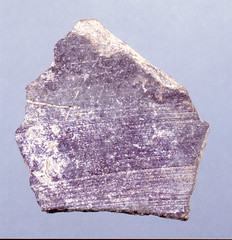ROYAL PURPLE: THE DYE OF GODS AND KINGS
My interest in the Phoenicians was especially piqued when amphora fragments, covered with an intense purplish coloration on their interiors, started turning up in the 13th century B.C. levels of the Sarepta (Lebanon) excavations. At another site, such sherds might be taken as a matter of course, perhaps due to staining by a manganese ore or an exotic fungus. But when you find them at a homeland Phoenician site, thoughts turn to the celebrated Tyrian or Royal Purple dye, which was worth more than its weight in gold and became the prerogative of priests and kings.
Even the names “Canaan” and “Phoenicia” likely derive from roots meaning “red” or “purple,” underlining the importance of dyed textiles in these societies. According to Greek legend, repeated by later writers, the dye was discovered by the Tyrian high god and king, Melqart, when he and the nymph Tyros went for a stroll on the Mediterranean beach with their dog. The dog chased ahead and bit into one of the mollusks that must have once littered the shore. It came back to its master, muzzle dripping with a purple substance. The discovery was not lost on Melqart, who immediately dyed a gown with the dye and presented it to his consort.
In fact, the first foray of our laboratory into what has been called biomolecular archaeology, so-named because it focuses on ancient organic compounds, was to put the Melqart legend to the scientific test. By applying a battery of analyses, we conclusively showed that the purple color inside the Sarepta amphoras was true molluscan Royal Purple or 6,6′-dibromoindigo, the earliest yet found within the confines of a Purple dye factory..
In this lecture, I will highlight the fascinating interplay of science, history, politics and religion in cultures around the world–Phoenicia, Peru, East Asia, Mesoamerica–where related species of the purple-yielding mollusks were culled for food and their dyeing potential in textiles. Because it requires as many as 10,000 animals to produce a gram of the dye, it was also very expensive to make. In each civilization, the molluscan Purple dye eventually came to be associated only with the highest political authorities and was imbued with special religious significance. Kimonos were dyed entirely in Purple, and the extremely well-preserved textiles of the Paracas and Nazca cultures of Peru and northern Chile exhibit stunningly beautiful patterns in Purple. In 1st century Rome, Nero issued a decree that only the emperor could wear the purple–hence, the name Royal Purple.

